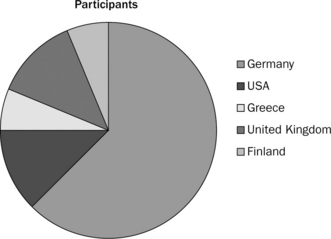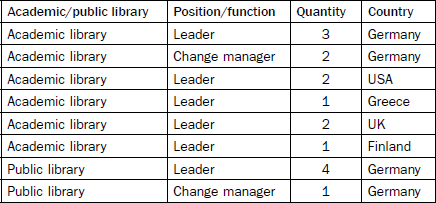When does change need change management?
Abstract.
In this chapter information is presented about the research process which involved 16 case studies of major change projects in academic as well as public libraries. Some of the case studies are described by leaders; some are from the point of view of personnel and organisational developers supporting major changes as change managers. There is also an overview of the time after the change project was completed.Subsequent chapters go on to describe the change projects in detail, beginning with the change project in one library, followed by aspects of the leadership style during this change process and the communication style and tools used or, rather, preferred.At the end of each of these case studies recommendations for other leaders overseeing similar change processes are presented.
3.1 Case studies of change projects in academic and public libraries
In Chapters 4 to 8 examples of processes in libraries that needed change management are described by team leaders, department leaders and directors as well as change managers. Every change project is based on the idea of an ideal user- oriented library which focuses on the needs and wishes of its users and customer satisfaction.
The examples range from the relocation of a library to the implementation of a library RFID (Radio Frequency IDentification) management system, the merger of libraries as well as the integration of an information provider, the implementation of a quality management system, a reduction in the amount of space, the announcement of a new director, management restructuring and how to cope with change as day-to-day business (see Table 3.1).
Table 3.1
Topics of the expert interviews
| Academic library* | Public library |
| Quality management (Leader/quality management coordinator) |
Relocation (Leader) |
| Library RFID management system (Leader) |
Library RFID management system (2 leaders and change manager) |
| Merger (Change manager and leader) |
Merger (Leader) |
| Merger, quality management and downsizing (Leader) |
|
| Reduction of space (2 leaders) |
|
| Announcement of a new director (Leader) |
|
| Management restructuring (Leader) |
|
| Change as day-to-day business (Change manager) |
|
| Becoming a leader as a result of ongoing changes (Leader – see Chapter 10.2) |
*Academic libraries are defined in this research project as university libraries, national libraries as well as research libraries.
For this the author completed 12 (verbal and written) expert interviews with library directors or with leaders of departments or teams, and three expert interviews with change managers. Another case study can be found in section 10.2. This makes a total of 16 expert interviews.
3.1.1 Which countries do the participants come from?
Figure 3.1 shows from which countries the leaders and change managers came who participated in this research project (including the case study described in section 10.2). As can be seen, the majority came from Germany, but other backgrounds were included to see if there were major cultural differences in the handling of deliberate large-scale changes. Thus leaders from the USA, Greece, the United Kingdom and Finland also participated in this research project.
More detailed information can be found in Table 3.2 which lists leaders and change mangers according to type of library as well as the country they came from.
As can be seen in the following chapters, there are no great differences in the handling of major changes in these countries. Each change project had its own special aspects that needed to be considered which led to variances in approach taken by the respective leader, but these were not based on cultural differences.
3.1.2 Are the participants male or female leaders and change managers?
A further aspect of interest was whether it made a difference if the leader was a woman or a man. In Table 3.3 it can be seen that the leaders of the participating academic libraries were relatively uniformly distributed between male and female. From public libraries more male leaders participated in this research project. All the change managers were female.
All in all no major differences between female and male leaders could be found in the handling of deliberate large- scale changes. The only differences that could be found were where male leaders described their leadership styles as more authoritarian (see sections 4.2.2 and 5.4). This is not to say that male leaders usually tend to be more authoritarian than female leaders. For example, in another (small) research project about leadership styles in academic libraries, a female leader said in an expert interview that she tends to lead – being new at her management position – more often using an authoritarian than a cooperative leadership style as her general method (Berke, 2012).
Both leaders with an authoritarian leadership style had some problems with missing competences and authority they thought should have been given to them by their superiors or the directors of their institutions/libraries. As no one else in this research project mentioned this kind of problem, it could perhaps be an explanation for a more authoritarian leadership style – which would make another interesting research project in its own right.
3.1.3 How much time did the participants have to conduct their change projects?
What became clear throughout this research process was that most of the libraries that had to cope with a deliberate large-scale change did not have a lot of time to fulfil the new requirements of their libraries.
The time allocated for these deliberate major large-scale change projects ranged from four months up to five years, although most needed to be finished within a year. The average duration of these nine change projects in libraries was about 7.8 months. In Figure 3.2 the duration of each change project analysed can be seen. Two of the major change projects in libraries are still ongoing and one has a second stage still to be finished, calculated to require three more months to make a total of 7.5 months for this major change (see Figure 3.2 – ‘Reduction of space II’ and ‘Reduction of space II including construction works’).

Figure 3.2 Duration of the change projects in months*
*Without the implementation of a library RFID management system in a public library which is still ongoing (section 4.2.1), the announcement of a new director in an academic library which is also still ongoing (section 7.1), and change as day-to-day business in an academic library (section 8.3).
In one library the leader has had to handle three major changes over a 13-year period (see section 5.4), taking two years, eight months (with a parallel integration process lasting six years) and five years respectively.
The library in which change has become day-to-day business has been handling deliberate large-scale changes for 12 years to date.
3.2 Change projects described by leaders
In Chapters 4 to 7 there are examples from different leaders and library directors who have all recently had to manage a deliberate large-scale change in their library. These leaders described the process, judged whether the change had been carried out successfully, and suggested what they might do differently in subsequent change projects. Thus these case studies may be taken as best practice to support other leaders in similar change situations.
All the leaders answered the following questions.
![]() What kind of change took place in your library?
What kind of change took place in your library?
![]() How have you acted as a leader during this change process?
How have you acted as a leader during this change process?
![]() In hindsight, would you act differently? What would be your advice for leaders in similar change projects?
In hindsight, would you act differently? What would be your advice for leaders in similar change projects?
![]() How have you involved your team? How could your team participate in the change process?
How have you involved your team? How could your team participate in the change process?
![]() What kind of communication tools (e.g. meetings, intranet and email) have you used? Have you communicated differently than before?
What kind of communication tools (e.g. meetings, intranet and email) have you used? Have you communicated differently than before?
![]() Have you experienced any resistance? If yes, how have you managed it?
Have you experienced any resistance? If yes, how have you managed it?
![]() Has your change project been successful? Have you achieved your own or your library’s goals?
Has your change project been successful? Have you achieved your own or your library’s goals?
![]() Which kind of (special) competences do you recommend for leaders in times of change?
Which kind of (special) competences do you recommend for leaders in times of change?
3.3 Asking change managers for another view on change projects
In Chapter 8 the view of change managers and how they supported their leaders and managers during a deliberate large-scale change is included to provide a further point of view.
In all three cases change managers are personnel or organisational developers that supported the management of the library during a change process. They have a totally different perspective on change projects as well as the leadership aspects involved.
Questions of interest answered by the change managers included the following.
![]() For how long have you been working as a change manager in your library?
For how long have you been working as a change manager in your library?
![]() What kind of change projects have you attended as a change manager?
What kind of change projects have you attended as a change manager?
![]() Have the leaders in your library acted differently during the change processes?
Have the leaders in your library acted differently during the change processes?
![]() Have your change projects been successful? Have you achieved your own or your library’s goals?
Have your change projects been successful? Have you achieved your own or your library’s goals?
![]() In your opinion, when does change need change management or a change manager?
In your opinion, when does change need change management or a change manager?
![]() Which kind of (special) competences do you recommend for leaders in times of change?
Which kind of (special) competences do you recommend for leaders in times of change?
Members of staff who are responsible for personnel or organisational development should always support change processes as change managers.



